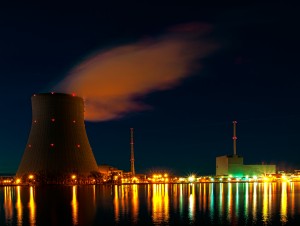 “Sustainable future” advocates seem to believe that solar, wind and hydro-electricity will eventually make up close to 100% of our energy generation, but there are benefits to having “central station” power plants in addition to distributed power generation. If the goal is to reduce greenhouse gas (GHG) emissions while assuring the health of our economy, the most viable way of generating central station power at present is nuclear fission.
“Sustainable future” advocates seem to believe that solar, wind and hydro-electricity will eventually make up close to 100% of our energy generation, but there are benefits to having “central station” power plants in addition to distributed power generation. If the goal is to reduce greenhouse gas (GHG) emissions while assuring the health of our economy, the most viable way of generating central station power at present is nuclear fission.
Central station power complements distributive power generation in two important ways. Central station power plants are better able produce power on a small area relatively close to where the energy will be consumed, reducing necessary transmission infrastructure. They also produce power when the sun is not out and the wind is not blowing.
Even when wind and solar power are fully deployed, we should maintain ~ 1/3 of our power generation as central station power, especially close to industrial centers and large urban areas. Natural gas is the best of the fossil fuels for central station power generation because it emits about half the CO2 per megawatt hour of electric energy produced as coal. However, it still results in substantial, undesirable GHG emissions.
Power plants based upon fuel crops and even bio-waste are usually thought of as renewable and sustainable, but they will not be easy to implement as central station power sources if our goal of ~1/3 of our electricity (roughly 300 GW) coming from central station power. Even with concerns over cost, nuclear waste and safety, the obvious alternative is nuclear power. The costs are driven largely by safety, which could be reduced by building identical reactors on similar sites instead of designing and building unique reactors for each seemingly arbitrarily selected site. There may be legitimate concerns over nuclear waste disposal, but there are several engineering solutions for disposal, were they not rejected for non-technical reasons.
Recognizing the need for central station power for our country, we must adopt new approaches to reactor design and construction and appropriate new policies that will support nuclear power generation within these new approaches.
Renewable energy sources like solar and wind cannot provide (yet) reliable, dispatchable baseload power. Potentially nuclear power could make a greater and more valuable contribution. But more innovative technology and… Read more »
The question was: are there viable alternatives to nuclear central power generation (for baseload grid needs)? Of course, there are lots of fossil alternatives, but I assume he is asking… Read more »
To buttress the recommendations by Professor Hammer and Dr. Perelman, it is unlikely that renewable energy sources such as solar and wind can provide baseload power not only reliably, but… Read more »
There are 4 new nuclear reactors currently under construction in the United States. All these 4 are adopting AP1000 design. These projects have experienced delays of over 3 years so… Read more »
Chi-Jen Yang makes some very good points. In particular the lack of operating flexibility for a nuclear generation plant is very important as it relates to the future of our… Read more »